My first High Adventure started at the beginning of World War II on December 7, 1941. One of our neighbors who owned an ambulance business in San Luis Obispo, California, was shouting the news as he drove around in one of his long white ambulances. I was four years old.
We drove to my grandparent’s house that Sunday. Nana was busy ironing and crying as she worked. I was too young to understand the implications but I knew that since grown-ups didn’t cry, this was a very bad sign.
We were at the beginning of a major lifestyle change that affected the whole country. It soon became everybody’s war and impacted us daily. People really got behind the military effort and worked together. The press, unlike today, used fake news for positive headlines. Nobody wanted to hear bad news. The fact was, at the beginning, we were losing.
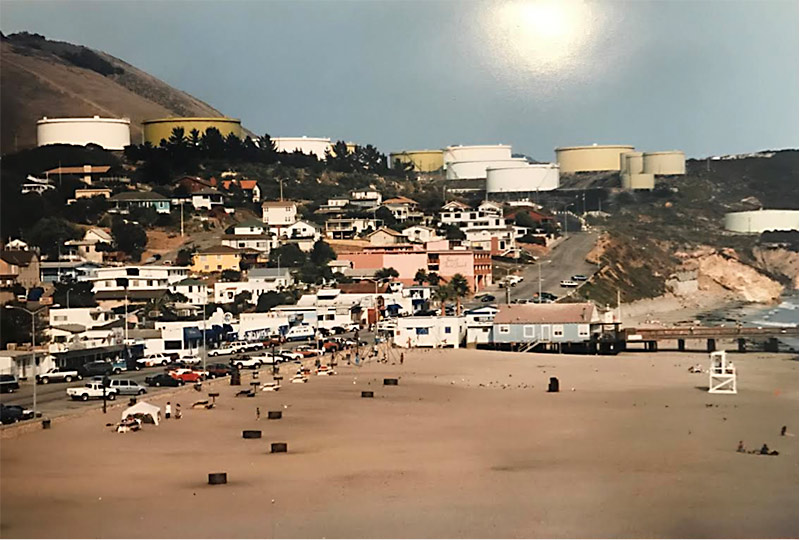
Avila Beach when Union Oil storage tanks were still in place. Now long gone.
We lived 10 miles inland from Avila Beach, home to the lengthy Union Oil Pier. Oil from the Salinas Valley was stored in the oil tanks on top of a hill, and then pumped out to the end of the pier. Oil tankers docked there empty, and when they were full, the red paint on the hull disappeared underwater; and only the black part of the hull was exposed. Some of the oil tankers, before the war, were Japanese who purchased oil from Union.
“The Japanese were very familiar with Avila," my mother explained later when I was old enough to understand. Shortly after the war began, a tanker captain came in with an “empty," but declined to take out the ship when it was loaded.
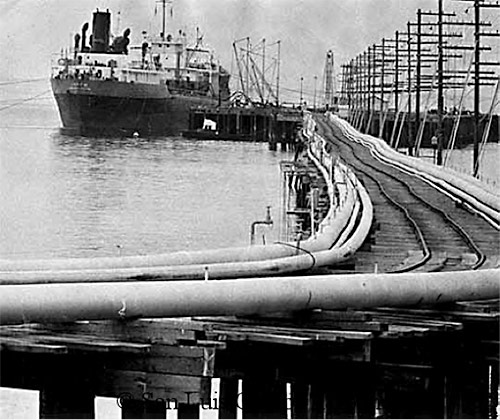
“A Jap submarine has been shadowing us,” he said. “He’s waiting until the tanker is full and leaves Avila. Then he will probably try to sink my ship—but I won’t be onboard.” Union found another captain, but the first captain was correct. The tanker headed north and was torpedoed before it reached Morro Bay. The crew escaped as the vessel sank, and fortunately they all survived. The explosion broke windows in San Luis about 15 miles away.
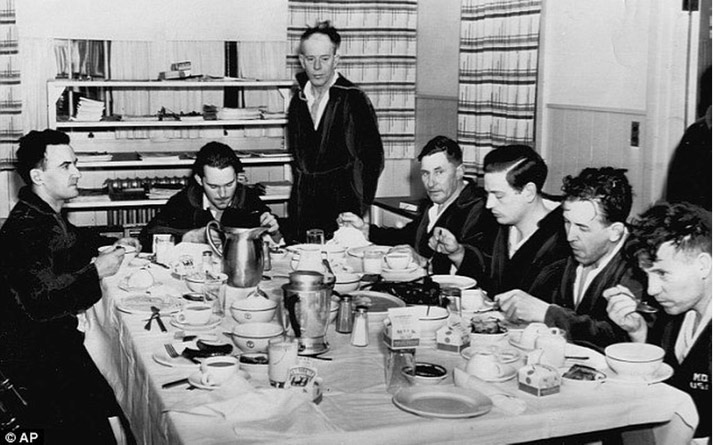
Rescued crewman
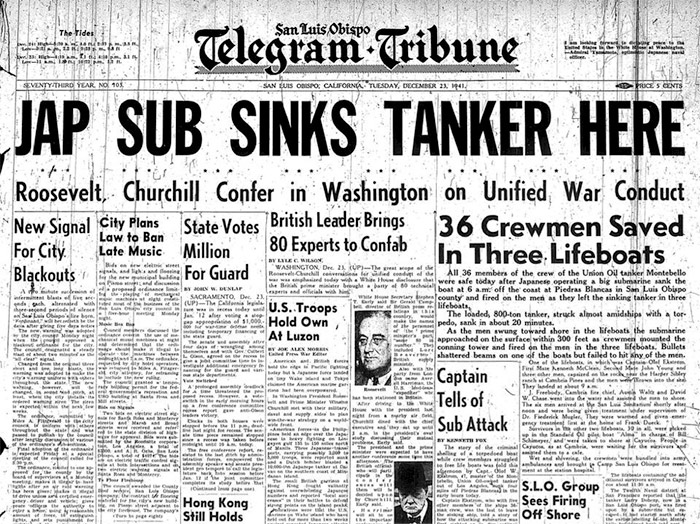
This event was classified information for years after the war. It certainly worked as a scare tactic at the time, as did the shelling by a Japanese submarine on February 4, 1942, of an oil facility a few miles north of Santa Barbara.
As a child I wondered why the Japanese didn’t seize the port at Avila and use it to fuel warships for an attack on the West Coast, not realizing then that there was a big difference between occasional submarine sorties and a land invasion.
It took awhile before security was put into place as the Pearl Harbor attack seemed to be a total surprise. The Japanese wanted to expand their hegemony over all of Asia, as well as encompass the islands of the Western Pacific, so as to discourage the United States from interfering with their plans for domination of their sphere of influence.
My parents belonged to the Avila Yacht Club. Rather than being a status organization, it was a large rustic building built off the civilian pier. I remember having my picture taken on the beach in a tiny dark-blue bathing suit complete with pail and shovel.
Local small-boat owners had built the Yacht Club themselves after a ship carrying the necessary timber had blown onto the shore during a storm; the crew jumped ship and one of the future Yacht Club members climbed onboard and claimed selvedge rights. Furnished with everyone’s cast-off furniture, members often had pot-luck dinners there after the sailboat races The members had not quite finished the building, but the Coast Guard, and later the US Navy, commandeered the building and thus had a presence there. By the time the war was over, the building was finished and equipped with Navy-insignia china and “silverware,”which was so worn that one could taste the cheap brass under the plating.
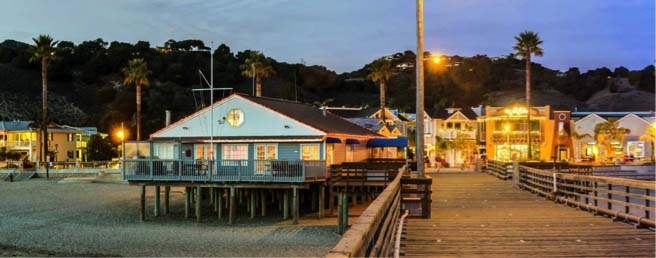
Avila Yacht Club
Eventually the beach at Avila was bulldozed with sand heaped into a slope so that the military could lie on their stomachs and fire at anyone who tried to make a landing there. Alas, our beautiful swimming beach was now off-limits as was the public pier and there were no more sailboat races.The military acquired “ducks,” which like James Bond’s vehicles, could operate on both land and water. A lookout tower appeared on the civilian pier. Although the government prepared for it, the Japanese didn’t try to land there.
Volunteers located themselves on top of a downtown building and were furnished with pictures of aircraft outlines so they could recognize any that weren’t American. We had to black out our houses at night to discourage aerial attacks from a Japanese aircraft carrier (these had been used at Pearl Harbor) so we purchased black oilskin shades we could roll down at night. Sometimes we had air raid siren warnings when we were supposed to depend upon flashlights and candles behind the oilskin. Grandpa was an air raid warden.
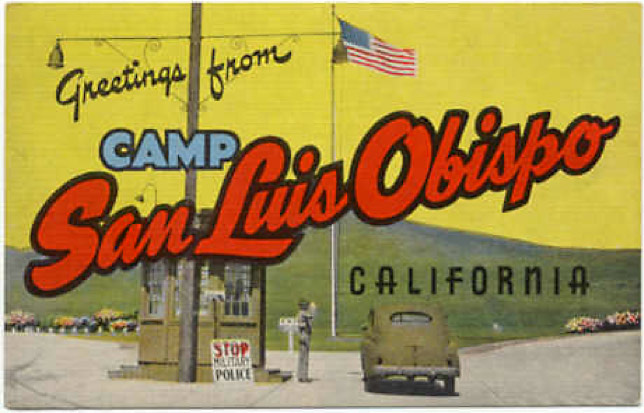
There was a military facility called Camp San Luis Obispo just up the hill from town. Before long, 5,000 Marines, in need of basic training skills, were assigned there. San Luis was not equipped for the population explosion and soon officers and their families arrived. Local residents, including my parents, housed a young military couple with a child my age. Since we only had two bedrooms, the visitors moved into the master bedroom while my parents camped out in the living room.
Ration stamps came into use, and kids were given the job of pasting the stamps into little books. The ration stamps allowed us to purchase shoes, tires, butter, etc. Stores substituted margarine, made with vegetable oil, but it was an unappetizing white, until the manufacturers added a dye bubble and sold a whole pound encased in thick plastic. The kids in the family were called upon to help. We massaged the red dye bubble inside until it burst, and massaged it some more to hopefully mix the dye so that it would all turn out yellow. It never really did, but developed orange streaks.

Eggs were rationed, even though our neighbors kept chickens. Nana knew about preserving them in a thick, transparent liquid she mixed up and called water glass. This apparently kept oxygen away from the egg shells.
Since soap was also rationed, Nana and Mommy learned how to make their own. Although I was there to help, I don’t recall exactly what was involved. Something was boiled on the stovetop into a brownish liquid that smelled terrible. After being poured into cardboard boxes heavily lined with waxed paper, this concotion was allowed to cool, then was sliced into pieces. The pieces didn’t set evenly and left some peaks and sharp edges.
Victory gardens became popular and women came to town to give free lessons on how to put up vegetables and fruit in Mason jars.
Victory bonds went on sale.
Silk stockings with a seam down the back were the fashion, but soon there was no more silk from the Orient available. Nylon stockings hadn’t yet been invented. Leg makeup went on sale and women used eyebrow pencil to mimic the seam down the back. This was impossible to do on one’s own trying to face backwards. Grown women wearing pants was unthinkable unless one had a Rosie the Riveter job. Even later going downtown in jeans was a no-no.
The military was expanded through the draft. My mother was in a panic that Daddy would be drafted; she couldn’t bear the thought of him having to kill anyone. She insisted that he become a conscientious objector if the draft order happened, which fortunately it did not. Unlike the other mothers, Mommy didn’t donate bacon grease, cooking oil, or used tinfoil at the butcher shop.
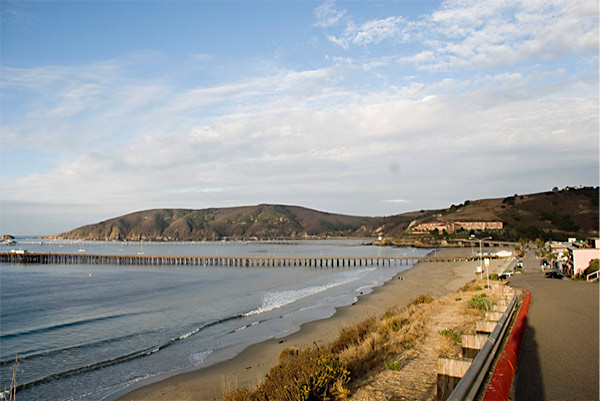
Avila Beach today
At first, West Coast residents were more concerned with the war against the Japanese and didn’t think too much about the war with Germany. Most of the European continent itself was controlled by Germany. England stood alone against Germany after the fall of France in June 1940, followed by the Battle of Britain in August of the same year.
There were some, in the British government, who had been in favor of an "accommodation" with Germany. Winston Churchill was now Prime Minister. He believed that Britain should stand fast until the last man and said that he would die fighting himself if necessary. He knew that atrocities visited on European citizens could not be ignored. When the Japanese attacked Pearl Harbor followed by the German declaration of war against the US, we could no longer avoid the conflict. We joined with Britain and other world allies and the rest is history.
It was totally unlike what we call war today. There were sharply defined "good guys and bad guys,” and the issues were clear. US citizens united, accepted rationing, accepted the draft, and somehow accepted the losses of our fighting men. Most everybody stood behind the effort to win, we knew we were going to win, we had to. In the meantime we put off our personal hopes and dreams for what was called the "duration." We were, truly, the United States of America.
|